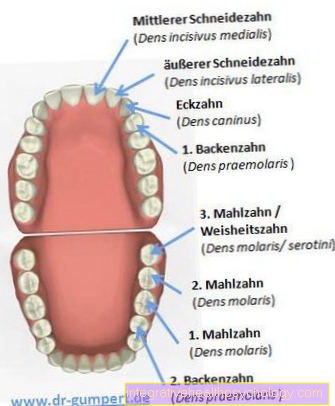Eye ointment with antibiotic
introduction
Eye ointments, the active ingredient of which is an antibiotic, are used for bacterial infections of the anterior segment of the eye. As a rule, the antibiotic eye ointments are prescribed by the ophthalmologist. There are different manufacturers with different locally acting broad spectrum antibiotics.

Effect of antibiotic eye ointments
Antibiotics have an inhibitory effect on bacteria by either disrupting their reproduction or their formation in such a way that the bacterial cells perish. In this way an infection caused by bacteria can be combated.
Active ingredients such as Aminoglycoside antibiotics such as tobramycin or gentamicin, and azithromycin are used. The very effective fluoroquinolones such as ciprofloxacin and ofloxacin are only prescribed for extremely severe disease processes.
If the inflammation of the eye was caused by a chlamydial infection, then tetracycline is an option.
Eye ointment with antibiotic and cortisone
Eye ointments with a combination of antibiotics and cortisone require strict medical control, as serious side effects such as breakdown of the cornea or increased intraocular pressure. In the case of glaucoma and fungal infections or herpes on the eye, eye ointments with antibiotics and cortisone must not be used at the same time.
They are prescribed by the ophthalmologist for bacterial conjunctivitis and after severe infections after injuries to the eye and if there is also an allergic reaction to the eye.
The addition of the glucocorticoid cortisone has an anti-inflammatory effect on the eye by locally suppressing the immune system.
An example of an eye ointment with antibiotic and cortisone is Dexa-gentamicin eye ointment with the active ingredients dexamethasone 0.3 mg / g and gentamicin sulfate 5.0 mg / g.
Learn more at: Eye ointment with cortisone
Indications for eye ointments with antibiotic
In principle, antibiotics only work against bacterial pathogens and not against viruses. As a general rule, the use of antibiotics should be strictly monitored to prevent the formation of resistant germs.
But even then, in the case of simple conjunctivitis, therapy should not start immediately with eye ointments containing antibiotics. Most conjunctivitis also heals with nonprescription, non-antibiotic eye drops or ointments. However, if the symptoms worsen or last longer than 5 - 7 days, a visit to the ophthalmologist is advisable.
However, if there is a chlamydial infection, an eye ointment with an antibiotic is necessary.
Eye ointment with antibiotic for stye
A stye is a small abscess on the edge of the eyelid, which is usually caused by staphylococcal bacteria.
Usually it is very painful, but it heals on its own. In the case of stubborn barley grains, however, the use of local antibiotics may also be necessary. Typically, the active ingredients gentamycin or erythromycin are used.
Under no circumstances should the stye be pierced or squeezed out, as this can damage the eyes and spread the pathogen.
Read on below: Eye ointment for a stye
Eye ointment with antibiotic for conjunctivitis
Conjunctivitis is one of the most common inflammations of the eye.
It is not always triggered by bacterial pathogens, but by a lack of tear fluid. Then an antibiotic is not useful for treatment. Rather, one should resort to tear substitutes. Even preparations containing cortisone are of little use in non-bacterial conjunctivitis, as they have an immunosuppressive and additionally drying effect.
However, if there is a bacterial infection or a very pronounced conjunctivitis, the use of an eye ointment with an appropriate antibiotic, which is prescribed by the ophthalmologist, is recommended.
You can also find out more at: Treat conjunctivitis
Are there eye ointments with antibiotics without a prescription?
Eye ointments containing antibiotics always require a prescription.
Over-the-counter eye ointments contain other active ingredients that are calming and disinfecting but not antibacterial. In the pharmacy e.g.
- the Bepanthen eye and nose ointment,
- Posiformin® 2% eye ointment and
- the Euphrasia eye ointment
available without a prescription.
The pharmacy will advise you on the right over-the-counter eye ointment.
This could also be of interest to you: Euphrasia eye drops
What are the side effects of eye ointments containing antibiotics?
Depending on the active ingredient, the different eye ointments have different side effects. The information on the package insert and from the pharmacist and ophthalmologist must be observed.
TOBRAMAXIN® eye ointment with the active ingredient tobramycin has the following side effects:
-
common: redness, burning sensation after application, allergic reactions to the eye
-
Occasionally: Inflammation of the surface of the eye, damage to the cornea, blurred vision, redness and swelling of the eyelids, pain, itching, dryness, increased lacrimation, in addition general hypersensitivity, headache, loss of eyelashes, skin pigmentation disorders, itching
-
very rare: nerve damage, eczema, wound healing disorder
For the Floxal 3mg / g eye ointment with the active ingredient ofloxacin, these side effects are indicated:
-
common: eye discomfort, eye irritation
-
rare: deposits on the cornea
-
very rare: hypersensitivity, shortness of breath, hives, reddened and itchy skin
-
Frequency not known: tiredness, odor and taste disturbance, nausea, sensitivity to light, burning sensation in the eye, reddening of the conjunctiva, visual disturbance, foreign body sensation, pain, swelling, itching of the eye
Few side effects are known for the GENTAMICIN POS eye ointment:
-
very rare: dilated pupils, hypersensitivity reactions
-
Possible further side effects: burning sensation, itching, reddening of the eye and impaired wound healing after a corneal injury
Contraindications to eye ointments with antibiotics
GENTAMICIN POS eye ointment must not be used if you are allergic to the components.
Floxal 3mg / g eye ointment should not be used if you are allergic to the ingredients or if the retina or the vitreous humor are inflamed. It should also be noted that exposure to UV light (sun, solarium) should be reduced during treatment with Floxal 3mg / g eye ointment.
TOBRAMAXIN® eye ointment should not be used if you are allergic to the ingredients, if you have kidney insufficiency or inner ear hearing loss, or if you have myasthenia gravis or Parkinson's.
The information given by the doctor and pharmacist as well as the package insert for the medication must be observed.
What interactions do eye ointments have with antibiotics?
GENTAMICIN POS eye ointment must not be used together with
- Amphotericin B,
- Heparin,
- Sulfadiazine,
- Cephalotin and
- Cloxacillin can be used.
Floxal 3mg / g eye ointment should not be used on the eye with preparations that contain zinc, mercury or lead.
TOBRAMAXIN® eye ointment is not simultaneously with
- Polymyxin B,
- Colistin,
- First generation cephalosporins (e.g. cefalotin),
- Vancomycin,
- Cisplatin and
- To use etacrynic acid.
In addition, when taking muscle relaxants together with TOBRAMAXIN® eye ointment, the risk of neuromuscular blockade must be taken into account.
Dosage and use of eye ointments with antibiotics
The dosage of the eye ointment is based on the information in the package insert and the instructions of the prescribing doctor.
As a rule, a strand of ointment from half a cm to one cm corresponds to a single dose. This is applied 2-3 times a day into the binding sac of the eye, avoiding touching the tip of the tube with the eye or unwashed hands.
The application should not last longer than 14 days.
With TOBRAMAXIN® eye ointment, a 1.5 cm long strand of ointment is a single dose that should be applied 3 times a day. For infections with Pseudomonas aeruginosa TOBRAMAXIN® eye ointment can be used every 3 to 4 hours.
Can you use antibiotic eye ointments during pregnancy and while breastfeeding?
Eye ointments with an active ingredient combination of an antibiotic (often tetracycline) and glucocorticoid (cortisone) must not be used during pregnancy and breastfeeding.
There is too little experience with the use of GENTAMICIN POS eye ointment in pregnant women to make a recommendation. However, the active substance is not expected to be absorbed into the mother's or even the child's bloodstream. The same applies to breastfeeding.
Since the harmlessness of Floxal 3mg / g eye ointment for mother and child during pregnancy and breastfeeding cannot be guaranteed, use during this time should be avoided.
The use of TOBRAMAXIN® eye ointment is not recommended during pregnancy and breastfeeding.
The obstetrician, pharmacist and gynecologist can answer further questions about the use of medicines during pregnancy and breastfeeding.
Find out more at: Medication during pregnancy - you should know that!
Are eye ointments with antibiotics applicable to babies?
The antibiotic moxifloxacin is intended for newborns and azithromycin is intended for use in eye ointments for children from the age of two.
The antibiotic group of tetracyclines should be avoided in children under eight years of age, as it can lead to tooth enamel discoloration and disturbances in bone development.
What does an eye ointment with antibiotic cost?
Since eye ointments with antibiotics are prescribed by the doctor, the health insurance company pays for the drug.
The co-payment is 10% of the drug price, with a minimum of 5 € and a maximum of 10 €. Eye ointments that cost less than € 5 are paid for directly by the patient.
What are the alternatives to eye ointments with antibiotics?
The ophthalmologist decides whether it is necessary to use eye ointments with antibiotics. Is there e.g. If you have non-bacterial conjunctivitis, other eye ointments or drops can be used as an alternative.
They are popular
- Parin POS® eye ointment containing heparin,
- Euphrasia eye drops,
- Berberil N eye drops,
- Panthenol eye ointment or
- Oleovital® eye ointment.
Recommendations from the editorial team
You might also be interested in these topics:
- Eye ointments
- Eye drops containing antibiotics
- Antiviral eye drops
- Eye drops and beta blockers
Exclusion of liability / disclaimer
We would like to point out that medication must never be discontinued, applied or changed independently without consulting your doctor.
Please note that we cannot claim that our texts are complete or correct. The information may be out of date due to current developments.













.jpg)















